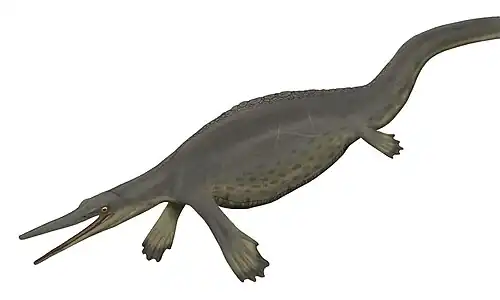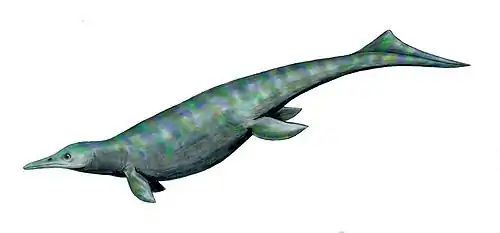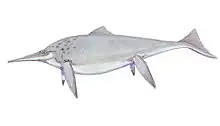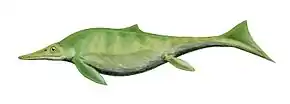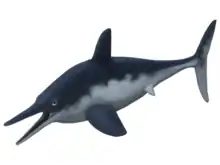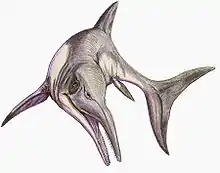Baisesaurus
Baisesaurus (meaning "Baise lizard") is an extinct genus of ichthyosauromorph from the early Triassic (Spathian) Luolou Formation of Guangxi, China. The genus contains a single species, B. robustus, known from a partial postcranial skeleton.[1]
| Baisesaurus Temporal range: Early Triassic, | |
|---|---|
| Scientific classification | |
| Domain: | Eukaryota |
| Kingdom: | Animalia |
| Phylum: | Chordata |
| Class: | Reptilia |
| Clade: | †Ichthyosauromorpha |
| Genus: | †Baisesaurus Ren et al., 2022 |
| Species: | †B. robustus |
| Binomial name | |
| †Baisesaurus robustus Ren et al., 2022 | |
Discovery and naming
The Baisesaurus holotype specimen, CUGW VH107, was discovered in 2018 in a layer of the Luolou Formation in the Nanpanjiang Basin of Zhebao Township, Longlin County, Baise, Guangxi region, China. The specimen consists of assorted ribs, gastralia, a limb element (likely a radius), 12 vertebral centra, and seven neural arches.
In 2022, Ren et al. described Baisesaurus robustus, a new genus and species of basal ichthyosauromorph. The generic name, "Baisesaurus", combines a reference to the type locality in Baise, China, with the Greek "saurus", meaning "lizard". The specific name, "robustus", means "robust".[1]
Description
Baisesaurus was likely at least 3 m (9.8 ft) long. It was more similar to Utatsusaurus than to any other ichthyosauromorph, with similar size and anatomical traits. It can be inferred from related animals that Baisesaurus was a strong swimmer with long, compact forelimb bones.[1]
Classification
Baisesaurus likely represents a basal member of the clade Ichthyosauromorpha. The describing authors explain that it may represent a member of the Ichthyopterygia. However, such a classification is highly tentative.[1]
References
- Ren, Jicheng; Jiang, Haishui; Xiang, Kunpeng; Sullivan, Corwin; He, Yongzhong; Cheng, Long; Han, Fenglu (2022-04-07). "A new basal ichthyosauromorph from the Lower Triassic (Olenekian) of Zhebao, Guangxi Autonomous Region, South China". PeerJ. 10: e13209. doi:10.7717/peerj.13209. ISSN 2167-8359. PMC 8995025. PMID 35415016.
